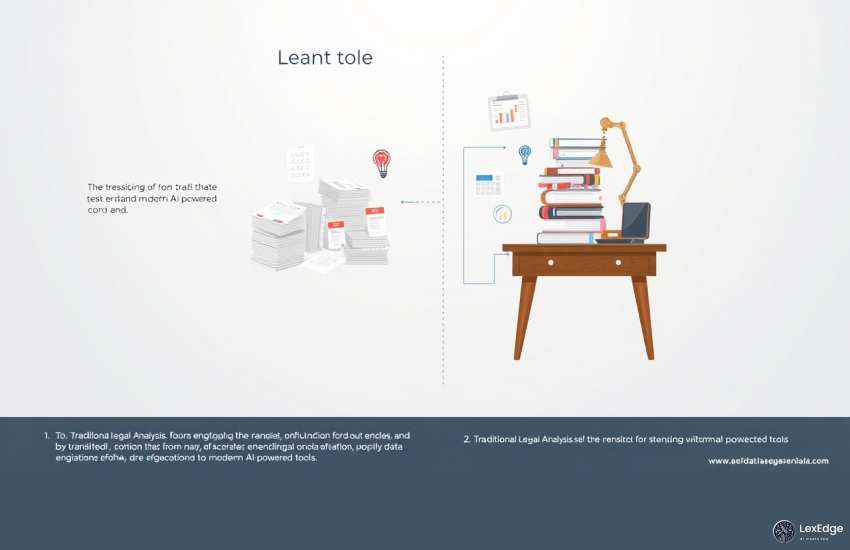Harnessing AI in Legal Analytics: A Transformative Leap

The article explores the evolution and impact of AI in legal analytics, detailing how technologies like machine learning and natural language processing are streamlining research, improving decision-making, and reducing operational costs. It also addresses critical challenges, including bias, privacy, and ethics, and looks ahead to emerging trends shaping the future of AI in law.
The Digital Transformation of Legal Analytics

The emergence of AI in legal analytics has brought a transformative shift to the legal industry. Instead of relying solely on manual reviews of cases and statutes, law firms now use advanced AI algorithms to process millions of legal documents in seconds. This innovation helps attorneys uncover patterns, predict case outcomes, and make faster, more informed decisions. By combining technology with human expertise, AI-powered legal analytics improves efficiency, accuracy, and client satisfaction. As a result, the legal profession is becoming more data-driven, transparent, and focused on delivering smarter, client-centered services.
How Did We Get Here? A Brief Origin Story

The journey of AI in legal analytics began in the early 2000s with simple document search systems and basic e-discovery tools. Over time, advancements in machine learning and natural language processing (NLP) revolutionized how legal professionals handle data. Modern platforms like Lex Machina and CoCounsel now enable lawyers to analyze judicial opinions, litigation histories, and case outcomes with remarkable accuracy. This evolution has transformed massive amounts of unstructured legal text into organized, actionable insights, empowering law firms to make smarter, data-driven decisions faster than ever before.
Core Benefits of AI in Legal Analytics

The benefits of AI in legal analytics are transforming how law firms operate and deliver value. First, AI enhances efficiency and speed by scanning extensive legal databases within seconds, drastically reducing research time and allowing attorneys to focus on strategic work. Second, it delivers enhanced accuracy, minimizing human error and often outperforming manual audits in specific legal tasks. Third, through cost reduction, automation of repetitive processes lowers client expenses and helps firms allocate resources to higher-value areas. Fourth, data-driven decision-making becomes more precise as AI analyzes past legal outcomes and opposing strategies, empowering lawyers with actionable insights. Lastly, personalized legal services are improving client engagement by offering tailored recommendations based on individual preferences and case history. Together, these advantages make AI-powered legal analytics a cornerstone of modern, efficient, and client-focused law practices.
Real-World Applications and Examples

- Lex Machina: Analyzes millions of court cases using AI in legal analytics to help lawyers forecast litigation strategies, assess risks, and make data-driven decisions.
- Contract Review Tools: Use artificial intelligence to identify key risks, clauses, and inconsistencies in contracts, greatly accelerating the review and approval process.
- Litigation Prediction: Employs AI-powered analytics to anticipate potential legal outcomes, enabling attorneys to plan strategies with greater confidence and accuracy.
- AI-Powered Chatbots: Streamline client interactions, automate onboarding, and enhance communication efficiency within law firms, improving client satisfaction and service quality.
Challenges and Critical Perspectives

While AI in legal analytics offers significant advantages, several challenges continue to shape its adoption and effectiveness:
- Bias in Data: AI systems can reflect biases present in their training data, leading to flawed or unfair legal recommendations.
- Limited Understanding of Legal Nuances: Even advanced AI tools may misinterpret complex legal language, context, or precedents.
- Privacy Concerns: Managing and protecting sensitive client and case data remains a major concern when implementing AI-driven systems.
- Ethical Considerations: Over-reliance on technology raises questions about accountability, transparency, and the human role in legal decision-making.
- Accessibility Barriers: Smaller law firms often face high costs and technical challenges in adopting AI-powered legal analytics tools.
Regulatory Uncertainty: The lack of clear legal frameworks around AI applications in law adds complexity and compliance risks for practitioners.
Emerging Trends and the Future of AI in Legal Analytics

The future of AI in legal analytics is rapidly evolving, driving innovation and transformation across the legal industry. Key trends shaping this future include:
- Increased Personalization: AI tools are enabling more personalized legal services, tailoring strategies and insights to meet individual client needs.
- Broader Integration: AI-powered analytics will extend beyond research to influence contract management, compliance, and case prediction, ensuring seamless integration across legal functions.
- Enhanced Predictive Accuracy: Continuous improvements in algorithms are increasing the precision of litigation outcome predictions, helping attorneys strategize more effectively.
- Ethical and Responsible AI Use: The legal sector is focusing on transparency, fairness, and ethical considerations to ensure trust in AI-assisted decisions.
- Democratization of Legal Technology: Advanced AI-driven tools are becoming more accessible, empowering smaller firms and independent practitioners to leverage data-driven insights once reserved for large organizations.
Conclusion
AI-driven legal analytics signify a paradigm shift in how law firms operate — bringing unmatched efficiency, predictive intelligence, and client personalization. However, true transformation lies in balancing technology with human expertise. Firms that embrace AI ethically and strategically will not only gain a competitive advantage but also redefine the standards of legal excellence in the digital era.

